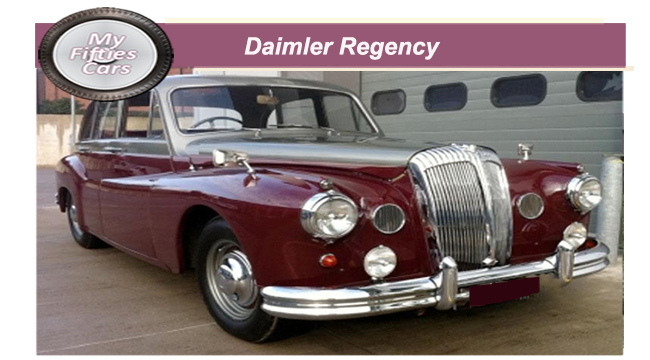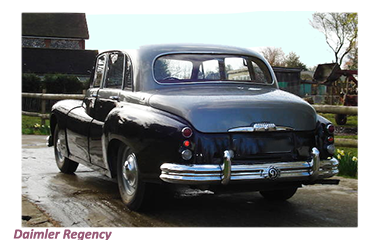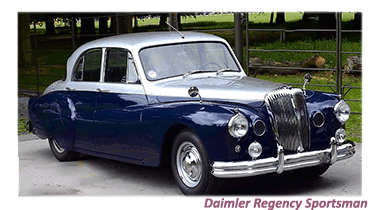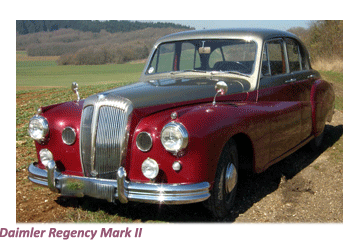
Daimler's second all-new post-war model, the Regency made its debut in 1951, following in the tire tracks of the short-lived and mostly unsung DE27/DE36 series,
 The Daimler Regency was built on a box-section chassis frame (with a cruciform centre section) and powered by a recently introduced over-head-valve six-cylinder engine, which would go on to provide the engineering basis for many later Daimler models, among them including the Regina, the 104 and the Majestic ranges.
The Daimler Regency was built on a box-section chassis frame (with a cruciform centre section) and powered by a recently introduced over-head-valve six-cylinder engine, which would go on to provide the engineering basis for many later Daimler models, among them including the Regina, the 104 and the Majestic ranges.
 In addition to its mechanics, some of the styling aspects of the Regency would also inspire the Daimler design team in engineering these later models as well as the more compact conquest.
In addition to its mechanics, some of the styling aspects of the Regency would also inspire the Daimler design team in engineering these later models as well as the more compact conquest.
The Regency’s chassis frame was swept up and over the line of the back axle in contrast to the DB18 and Consort chassis that was underslung.
Featuring Girling-type independent front suspension by coil springs and leading arms, and automatic chassis lubrication, the Daimler Regency was fitted with Girling hydro-mechanical brakes and cam-and-roller steering supplied by the renowned Marles company, innovators in the development of steering systems.
The Daimler Regency was powered by a six-cylinder version of the four which had made its debut in Daimler associate company Lanchester’s LJ200 Fourteen model.
 The LJ 200 also shared the same bore, stroke, valve gear and the same production machinery. Transmission, as ever, was by the well known Daimler fluid flywheel/pre-selector combination.
The LJ 200 also shared the same bore, stroke, valve gear and the same production machinery. Transmission, as ever, was by the well known Daimler fluid flywheel/pre-selector combination.
The Regency’s four-door six-light coach built bodies were provided by Barker, another subsidiary operating within the Daimler complex at the Radford factory in Coventry.
![]()
Just a year later, in 1952, the saloon was joined by a very smart convertible coupe which bore a strong resemblance to the Daimler Special Sports, though not sharing that body
T he first Regency was seen by auto historians as a “ toe in the water ” exercise for Daimler more than a serious long-term model range, with Daimler fully occupied with developing their new and successful Conquest model at the time.
he first Regency was seen by auto historians as a “ toe in the water ” exercise for Daimler more than a serious long-term model range, with Daimler fully occupied with developing their new and successful Conquest model at the time.
 The Daimler Regency remained in production till 1954 till it was superseded by the Daimler Regency II.
The Daimler Regency remained in production till 1954 till it was superseded by the Daimler Regency II.
Although the latest Regency version was visually similar to the 1951 model, Daimler claimed improvements all around and added more substantial and powerful engines, all without increasing the price.
 The new Regency's chassis was the same as before, although this time is sitting on a 114in wheelbase, Girling-type independent front suspension and automatic chassis lubrication.
The new Regency's chassis was the same as before, although this time is sitting on a 114in wheelbase, Girling-type independent front suspension and automatic chassis lubrication.
Fully hydraulic Girling brakes with 12in drums were now fitted on the 41/2-liter chassis, though the 372-litre retained the older hydro-mechanical system.
![]()
The six-light four-door body style was based on that of the first Regency, though it had a five-inch longer tail and a more substantial boot.
 Once again, the Regency was a medium-large Daimler with a short career, for Regency II would become the "104" just one year later, a car which looked similar but which offered considerably improved performance.
Once again, the Regency was a medium-large Daimler with a short career, for Regency II would become the "104" just one year later, a car which looked similar but which offered considerably improved performance.
Alongside the Regency II, Daimler also launched the Sportsman coupe, which stylistically, it was different from the standard limousine with four headlights, a wraparound rear window and even some prominent tail fins. Overdrive on top gear was offered on the Sportsman, but an automatic transmission finally became available for the first time in 1957.
 Even so, the simple and traditional pre-selector gearbox and fluid flywheel remained as the standard transmission system.
Even so, the simple and traditional pre-selector gearbox and fluid flywheel remained as the standard transmission system.
As impressive as the Sportsman was, the whole Regency II range was not produced in large numbers,
With the Regency, Daimler had proved to themselves as well as some of the motoring worlds that large saloons could be sporty, paving the way for the launch of the Majestic.
Take me back to the home page


